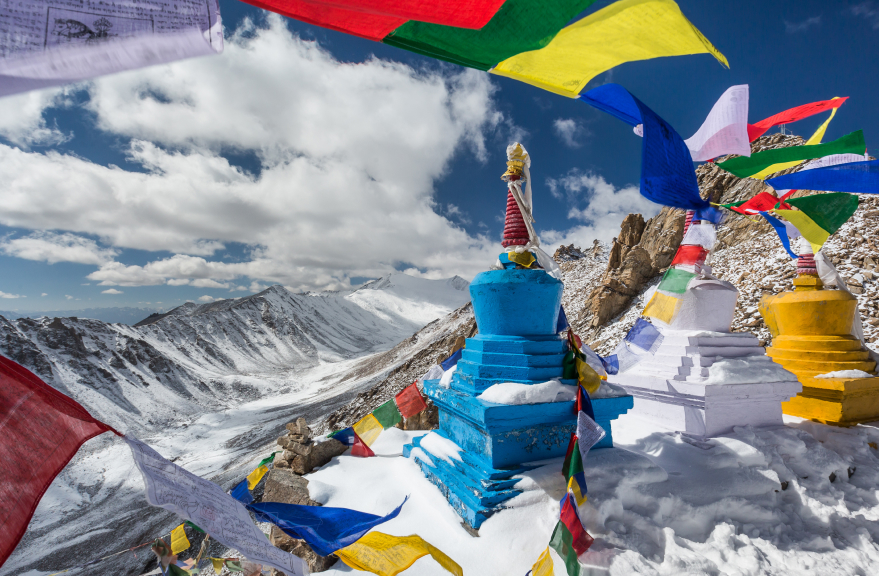Ultimate Guide to Exploring Khardung La Pass
Nestled in the majestic Karakoram Range, Khardung La Pass in Ladakh, India, holds the distinction of being one of the most sought-after destinations for adventure addicts and nature lovers. Though it may no longer hold the title of the topmost motorable pass, it continues to allure travellers with its stirring lookouts, literal significance, and the exhilaration of conquering its winding roads. This comprehensive trip companion provides precious information, sightseeing openings, and practical tips for those planning a memorable trip from Leh to Khardung La Pass.
Are you interested in experiencing the breathtaking beauty of Ladakh? Take a look at our enticing Ladakh Tour Packages.
Exploring Khardung La
Khardung La Pass holds great historical and strategic significance, making it an interesting destination for explorers and adventurers. Below is further information about its literal significance and the experience of standing atop the world’s loftiest motorable pass.
Historical Significance
Khardung La Pass has a rich history tied to its role as a strategic trade and military route. It was originally part of the ancient Silk Road, connecting Central Asia with the Indian subcontinent. Dealers would pass through this route, carrying goods and artistic influences between the regions.
In more recent times, Khardung La gained elevation during the 20th century, when it became a pivotal supply route for the Indian Army. This pass served as a lifeline for providing essential inventories to the Indian Army’s posts and bases positioned in the Siachen Glacier, known as the loftiest battleground in the world. The gruelling terrain and extreme weather conditions added to the significance of this pass for military operations.
Adventure and Accomplishment
Standing atop Khardung La Pass at an elevation of 5,602 meters (18,379 feet) is a remarkable feat in itself. The term” motorable” refers to the fact that it’s accessible by road, although the route is gruelling and requires technical vehicles.
For numerous travellers, reaching the peak of Khardung La Pass represents a particular achievement and a testament to their abidance and spirit of adventure. The trip to the pass involves navigating through steep ascents, hairpin bends, and rough terrain, making it a thrilling and indelible experience.
Stunning Natural Beauty
Beyond its literal and audacious aspects, Khardung La Pass offers admiration-inspiring natural beauty. As you ascend the pass, you will be treated to panoramic lookouts of the girding snow- limited Himalayan peaks, deep denes, and rugged geographies. The play of light and shadows on the mountains creates a mesmerizing visual spectacle.
The pass also serves as the gateway to the alluring Nubra Valley, famed for its graphic geographies, cloisters, beach stacks, and unique double-humped Bactrian camels. Exploring the Nubra Valley adds another subcaste of adventure and discovery to the overall experience of visiting Khardung La.
Tourism and Cultural Exchange
Over time, Khardung La Pass has gained popularity among excursionists and adventure lovers from around the world. Visitors flock to this region to witness the nobility of the Himalayas, witness the exhilaration of conquering one of the loftiest motorable passes, and immerse themselves in the original culture.
The region girding Khardung La is inhabited by friendly and welcoming Ladakhi people. Interacting with the locals provides an occasion to learn about their unique way of life, their traditions, and their deep-confirmed connection with the harsh yet beautiful Himalayan terrain.
Road from Leh to Khardung La
The trip from Leh, the capital of Ladakh, to Khardung La covers roughly 39 kilometres (24 miles). The initial part of the road from Leh to South Pullu is well-paved and fairly smooth, allowing for a comfortable drive. Travellers can enjoy the scenic geographies of the Ladakh region, which are characterized by barren mountains, deep denes, and occasional patches of verdure.
However, the final stretch from South Pullu to Khardung La itself is a clay and dirt track. This section of the road is more gruelling, with rough terrain, steep ascents, hairpin bends, and occasional water streams caused by melting snow. It requires conservative driving and a vehicle with good ground clearance. The audacious nature of this part of the trip adds to the overall exhilaration and excitement.
To make the most of the experience and avoid the tourist rush, it’s judicious to start the trip from Leh to Khardung La early in the day, rather than in the morning. This allows for better visibility, lower business on the road, and ample time to explore the pass and girding areas.
Continuing to Nubra Valley
After reaching Khardung La Pass, tourists can continue their trip to explore the stirring beauty of Nubra Valley. From the pass, the road descends, taking tourists through the townlets of Khardung and Khalsar. These townlets offer casts of local life and give openings to interact with the friendly Ladakhi people.
As the trip continues towards Siachen Glacier, tourists will pass through the townlets of Panamik and Warshi. Panamik is known for its hot springs, where visitors can relax and rejuvenate amidst graphic surroundings. Warshi, on the other hand, offers a tranquil and untouched air, giving a unique experience of Ladakh’s remote and pristine geographies.
For those seeking a more odd and immersive experience, Turtuk village is a retired gem located roughly 164 kilometres (102 miles) down from Khardung La Pass. Turtuk is known for its scenic beauty, apricot vineyards, and the warm hospitality of its Balti community. It offers regard into the lives and culture of a different ethnic group within the Ladakh region.
The village of Diskit, positioned about 75 kilometres (47 miles) from Khardung La Pass, is another major magnet in Nubra Valley. It’s known for its ancient Diskit Monastery, which houses a towering statue of Maitreya Buddha and offers panoramic views of the valley.
Road Conditions and Permits
The road from Leh to Khardung La remains open throughout the year, but it’s important to be apprehensive of the varying road conditions. While the original part of the road is fairly well-maintained, the final 14 kilometres (8.7 miles) leading to the pass can be gruelling. It frequently has broken sections, slush, and water streams caused by melting snow, making it necessary to drive cautiously and rather with a sturdy vehicle.
To visit Khardung La Pass, travellers must gain an inner-line permit. The permit can be acquired from the District Commissioner’s (DC) office in Leh or applied online through the sanctioned website. It’s important to carry multiple photocopies of the permit, as they need to be submitted at each checkpoint, including South Pullu and North Pullu.
Modes of Transportation
Various transportation options are available for travellers to reach Khardung La Pass and explore Nubra Valley. Hiring a cab is a popular choice, ranging from cruisers to SUVs. The cost of hiring a cab for a round trip from Leh to Khardung La is roughly Rs. 2,300 to Rs. 2,600.
Also Read: Ladakh Tempo Traveller Rates List
Shared taxicabs can be found at the Leh Bus Stand, offering a more budget-friendly option. However, it’s important to note that these shared taxicabs drop passengers at the pass and don’t arrange for the return trip, so tourists need to plan their return transportation consequently.
Buses also operate between Leh and Nubra Valley, but the timing and frequency may be limited. It’s judicious to check the bus schedules in advance and plan consequently.
For adventurous individuals, bike rentals are available in Leh, allowing tourists to ride their motorcycles to Khardung La Pass. However, it’s essential to have previous experience in riding in mountainous terrains and be well-prepared with safety gear and spare parts.
Suggested Read: Rent a cycle in Leh Ladakh
Experienced cyclists may also choose to ride their bikes to Khardung La, taking on the challenge and enjoying the scenic beauty at a slower pace. It’s important to ensure physical fitness and adaptation to the high altitude before attempting such a trip.
Also Read: Ladakh Bike Trip Budget
Best Time to Visit
The best time to visit Khardung La Pass is from June to September, which corresponds to the summer and early autumn months in the region. During this period, the weather at the pass is fairly affable, and road conditions are generally better compared to other times of the year.
From June to September, Ladakh experiences its peak tourist season. The temperatures at Khardung La Pass during these months range from around 10 °C to 20 °C (50 °F to 68 °F), making it more comfortable for tourists to explore the area. The days are longer, allowing for ample daylight to enjoy the stunning geographies and take part in outdoor activities.
One of the main advantages of visiting Khardung La Pass during this time is that the pass remains accessible to vehicular traffic. The road leading up to the pass is in better condition, making the trip fairly smoother. Tourists can enjoy the exhilaration of driving or riding through the scenic mountainous terrain while having an advanced chance of reaching the pass without disruptions caused by heavy snowfall or road closures.
However, it’s important to note that indeed, during the summer months, the weather in the region can fluctuate, with unforeseen changes and occasional rainfall. It’s judicious to carry applicable apparel layers to stay warm and defended, as temperatures can drop significantly at the advanced mound.
After September, the threat of snowfall and avalanches increases in the region, leading to the closure of Khardung La Pass for vehicular traffic. The pass is generally closed from October to May due to heavy snow accumulation and unsafe road conditions. It’s pivotal to check with local authorities or tour drivers for the exact opening and ending dates of the pass, as they can vary depending on rainfall conditions and concurrence operations.
The period from June to September offers the best rainfall conditions and availability to visit Khardung La Pass. It allows trippers to enjoy the stunning geographies, witness the exhilaration of reaching one of the world’s loftiest motorable passes, and explore the girding areas of Nubra Valley. Being prepared for changeable rainfall changes is essential, indeed during the summer months, to ensure a comfortable and pleasurable visit to this iconic pass in the Ladakh region.
Essential Tips and Precautions
Adaptation
Leh, the gateway to Khardung La Pass, is located at a high altitude. It’s important to adapt duly before heading to the pass. Spend a couple of days in Leh, allowing your body to acclimate to the thin air and altitude. Avoid physical exertion during the first many days to minimize the threat of altitude sickness.
Physical Fitness
The trip to Khardung La involves navigating steep ascents and descents, as well as gruelling road conditions. Ensure that you’re physically fit to undertake this trip. Consult with a doctor if you have any pre-existing health conditions or enterprises regarding your fitness degree.
Layered Clothing
Weather conditions at high mounds can change fleetly, with temperature variations throughout the day. Dressing in layers allows you to adjust your apparel to the changing weather. Start with a base layer of moisture-wicking fabric, add insulating layers like a coat or sweater, and eclipse it off with a windproof and leakproof jacket. Carry gloves, a cap, and a scarf or neck gaiter to cover against cold winds.
Stay Doused
The high altitude and dry climate can lead to dehumidification. Drink plenitude of water throughout the day to stay doused. It’s recommended to carry an applicable water bottle and refill it whenever possible. Avoid inordinate consumption of caffeine and alcohol, as they can contribute to dehydration.
Altitude Sickness
Be apprehensive of the symptoms of altitude sickness, which can include headache, nausea, dizziness, fatigue, and shortness of breath. However, take it easy and allow your body to acclimate, If you witness mild symptoms. However, descend to a lower altitude incontinently and seek medical backing, If symptoms worsen or come severe.
Vehicle Maintenance
If you’re hiring a vehicle or bringing your own, ensure that it’s in good condition and suitable for rough terrains. Check the tyres, brakes, and overall mechanical condition of the vehicle before embarking on the trip. Carry a spare tyre, necessary tools, and emergency inventories such as a first aid kit, flashlight, and redundant food and water.
Photography and Waste Disposal
The geographies around Khardung La Pass offer stirring photo opportunities. However, it’s important to be a responsible traveller and admire the terrain. Carry a bag to collect your trash and dispose of it duly in designated bins. Avoid littering and follow local regulations regarding waste disposal. When taking photos, be aware of the surroundings and admire the privacy and artistic sensitivities of the local people.
Respect Local Culture
Ladakh has a rich artistic heritage, and it’s important to admire the local customs and traditions of the region. Dress modestly, particularly when visiting cloisters or religious spots. Be aware of original perceptivity and seek authorization before photographing individuals, especially monks and locals. It’s also judicious to learn many introductory felicitations and expressions in the local language, similar to “Jullay” (hello) and “Tashi Delek” (greetings), to show respect and interact with the locals in a friendly manner.
By following these essential tips and preventives, you can have a safe and pleasurable trip to Khardung La Pass, passing the awe-inspiring beauty of the region while esteeming the original culture and terrain.
Conclusion
Embarking on a trip from Leh to Khardung La Pass is an indelible experience that offers stirring views and a sense of accomplishment. While the road may present challenges, proper medication, adaptation, and adherence to safety guidelines will ensure a memorable and safe adventure. So, gear up, take in the majestic geographies, and produce lasting recollections on the stage of the Himalayas at Khardung La Pass, the gateway to the alluring Nubra Valley.

Request a call back
Our experts would love to create a package just for you!









